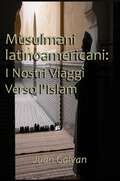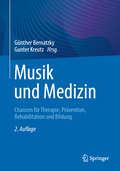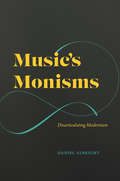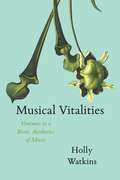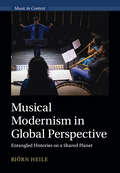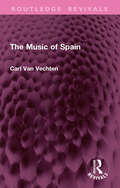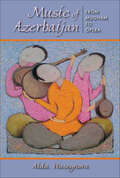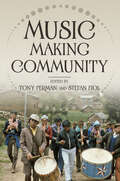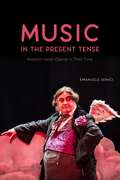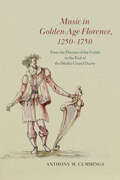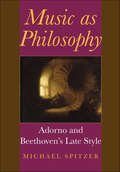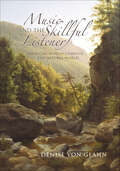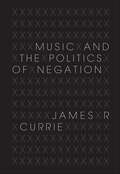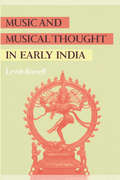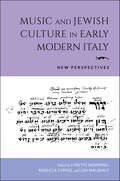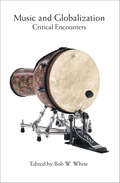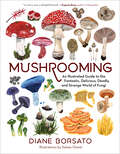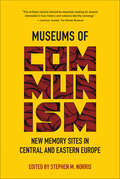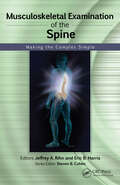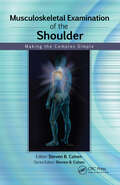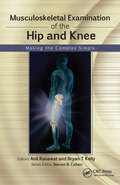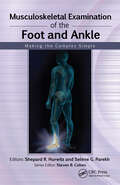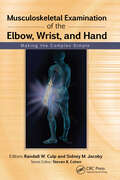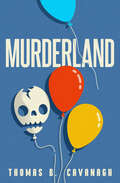- Table View
- List View
Musulmani latinoamericani: I Nostri Viaggi Verso l'Islam
by Juan Galvan“Questo libro vi farà piangere, ridere, meditare, sentire il potere e la pace. È un'eccellente introduzione di modelli di ruolo per una giovane generazione di Musulmani”. - Camilla Stein “Ecco un libro che vi riempirà le orecchie di un coro di voci che forse non avevate mai sentito così chiaramente. Ciò che amo di questa ampia raccolta di saggi di testimonianza, accuratamente introdotta, è la sua varietà, la sua inquietudine, la sua apertura, la sua gamma”. - Michael Wolfe, autore di The Hadj: An American's Pilgrimage to Mecca. Scoprite un'interessante raccolta di storie profonde sui viaggi personali delle persone verso l'Islam. All'interno di questo libro, scoprirete una raccolta di storie forti e personali sul viaggio di tutti i giorni dei latinoamericani verso la verità. Racconta le loro lotte, le loro scoperte e le loro rivelazioni durante questo viaggio spesso lungo e faticoso, raccontato con cruda emozione e onestà, che si conclude con l'accettazione finale della loro pace nell'Islam. Mentre alcuni racconti sono di amore e accettazione, pieni della positività di una famiglia solidale, altri sono segnati da angoscia e conflitto, mentre l'autore si scontra con la sua nuova fede e il suo posto nel mondo. Con riflessioni approfondite sull'Islam e sulla comunità latinoamericana, oltre a una grande quantità di informazioni sul Corano e sulla fede Islamica stessa, questo libro è uno sguardo aperto e onesto sulla vita dei musulmani latinoamericani e su come la loro fede li ha plasmati.
Musik und Medizin: Chancen für Therapie, Prävention, Rehabilitation und Bildung
by Günther Bernatzky Gunter KreutzDieses Buch beleuchtet die Wirkungen von Musik auf Gesundheit, Wohlbefinden und Lebensqualität aus der Sicht interdisziplinärer, musikwissenschaftlicher und medizinischer Forschung. Hochrangige Expert*innen aus vielfältigen Fachgebieten stellen die wissenschaftlichen Grundlagen für medizinische, therapeutische, pädagogische und andere Anwendung vor. Inhaltlich spannt es den Bogen von den psychophysiologischen Grundlagen emotionaler Wirkungen des Musikhörens bis hin zu musikmedizinischen und -therapeutischen Interventionen. Musik erweist sich vielfach als äußerst wirksame, nahezu nebenwirkungsfreie und vergleichsweise kostengünstige unterstützende Strategie für Prävention, Therapie und Rehabilitation in vielen medizinischen Fachbereichen.Ein breites Spektrum musikalischer Aktivitäten einschließlich Musikhören, Laienmusizieren, Chorsingen, Tanzen und verschiedene Formen musiktherapeutischer Strategien steht den Erfordernissen unterschiedlicher Zielgruppen, individuellen Unterschieden, Vorlieben und kulturellen Hintergründen gegenüber. Die Neuauflage wurde aktualisiert und mit Inhalten zu COVID 19 und einer neuen Sektion zu gesundheitlichen Belastungen durch Musik erweitert.Ärzt*innen und medizinisches Personal in Sozial- und Pflegeberufen erhalten profunde Informationen über Chancen und Grenzen musikbezogener Angebote. Die Kapitel eignen sich ebenso als Einstiege für Wissenschaftler*innen zahlreicher Fachrichtungen aus Sozial-, Natur- und Geisteswissenschaft.
Music's Monisms: Disarticulating Modernism
by Daniel AlbrightDaniel Albright investigates musical phenomena through the lens of monism, the philosophical belief that things that appear to be two are actually one. Daniel Albright was one of the preeminent scholars of musical and literary modernism, leaving behind a rich body of work before his untimely passing. In Music’s Monisms, he shows how musical and literary phenomena alike can be fruitfully investigated through the lens of monism, a philosophical conviction that does away with the binary structures we use to make sense of reality. Albright shows that despite music’s many binaries—diatonic vs. chromatic, major vs. minor, tonal vs. atonal—there is always a larger system at work that aims to reconcile tension and resolve conflict. Albright identifies a “radical monism” in the work of modernist poets such as T. S. Eliot and musical works by Wagner, Debussy, Britten, Schoenberg, and Stravinsky. Radical monism insists on the interchangeability, even the sameness, of the basic dichotomies that govern our thinking and modes of organizing the universe. Through a series of close readings of musical and literary works, Albright advances powerful philosophical arguments that not only shed light on these specific figures but also on aesthetic experience in general. Music’s Monisms is a revelatory work by one of modernist studies’ most distinguished figures.
Musical Vitalities: Ventures in a Biotic Aesthetics of Music (New Material Histories of Music)
by Holly WatkinsDoes it make sense to refer to bird song—a complex vocalization, full of repetitive and transformative patterns that are carefully calculated to woo a mate—as art? What about a pack of wolves howling in unison or the cacophony made by an entire rain forest? Redefining music as “the art of possibly animate things,” Musical Vitalities charts a new path for music studies that blends musicological methods with perspectives drawn from the life sciences. In opposition to humanist approaches that insist on a separation between culture and nature—approaches that appear increasingly untenable in an era defined by human-generated climate change—Musical Vitalities treats music as one example of the cultural practices and biotic arts of the animal kingdom rather than as a phenomenon categorically distinct from nonhuman forms of sonic expression. The book challenges the human exceptionalism that has allowed musicologists to overlook music’s structural resemblances to the songs of nonhuman species, the intricacies of music’s physiological impact on listeners, and the many analogues between music’s formal processes and those of the dynamic natural world. Through close readings of Austro-German music and aesthetic writings that suggest wide-ranging analogies between music and nature, Musical Vitalities seeks to both rekindle the critical potential of nineteenth-century music and rejoin the humans at the center of the humanities with the nonhumans whose evolutionary endowments and planetary fates they share.
Musical Modernism in Global Perspective: Entangled Histories on a Shared Planet (Music in Context)
by null Björn HeileIn the first study of the global dimensions of musical modernism, Björn Heile proposes a novel theory according to which musical modernism is constituted by a global diasporic network of composers, musicians and institutions. In a series of historical and analytical case studies from different parts of the world, this book overcomes the respective limitations of both Eurocentric and postcolonial, revisionist accounts, focusing instead on the transnational entanglements between the West and other world regions. Key topics include migration, the transnational reception and transfer of musical works and ideas, institutions such as the International Society for Contemporary Music (ISCM) and composers who are rarely discussed in Western academia, such as the Nigerian-born Akin Euba and the Korean-German Younghi Pagh-Paan. Influenced by the interdisciplinary notion of 'entangled histories', Heile critiques established dichotomies, all the while highlighting the unequal power relations on which the existing global order is founded.
The Music of Spain (Routledge Revivals)
by Carl Van VechtenFirst published in 1920, The Music of Spain deals with historical periods, schools and style and appears to embrace everything related to music provided it affects or is affected by Spain in some degree, no matter how small or insignificant. The period extends from the sixteenth century to the early twentieth century and the author encircles his subject in a huge ring or parenthesis that opens with Antonio Cabezon, the Spanish Bach (according to Pedrell) and closes with the gypsy dancer and singer Pastora Imperio, queen of the Spanish “varieties” stage of today. It brings themes like Spain and music; the land of joy; and from George Borrow to Mary Garden. This book is an important historical reference for students and scholars of history of music, Spanish music.
Music of Azerbaijan: From Mugham to Opera (Ethnomusicology Multimedia)
by Aida HuseynovaThis book traces the development of Azerbaijani art music from its origins in the Eastern, modal, improvisational tradition known as mugham through its fusion with Western classical, jazz, and world art music. Aida Huseynova places the fascinating and little-known history of music in Azerbaijan against the vivid backdrop of cultural life under Soviet influence, which paradoxically both encouraged and repressed the evolution of national musics and post-Soviet independence. Inspired by their neighbors to the East and West, Azerbaijani musicians enjoyed a period of remarkable creativity, composing and performing the first opera and the first ballet in the Muslim East, establishing the region's first Opera and Ballet Theater and Conservatory of Music, and discovering ways to merge the modal lyricism of mugham with the rhythmic dynamics of jazz. Drawing on previously unstudied archives, letters, and documents as well as her experience as an Azerbaijani musician and educator, Huseynova shows how Azerbaijani musical development was not a product of Soviet cultural policies but rather grew from and reflected deep and complex cultural processes.
Music Making Community
by Bruno Nettl Joanna Bosse Stefan Fiol Stephen Blum Veit Erlmann Eduardo Herrera Ioannis Tsekouras Donna A Buchanan Thomas Solomon Sylvia Bruinders David A McDonald Rick DejaMaking music offers enormous possibilities--and faces significant limitations--in its power to generate belonging and advance social justice. Tony Perman and Stefan Fiol edit essays focused on the forms of interplay between music-making and community-making as mutually creative processes. Contributors in the first section look at cases where music arrived in settings with little or no sense of community and formed social bonds that lasted beyond its departure. In the sections that follow, the essayists turn to stable communities that used musical forms to address social needs and both forged new social groups and, in some cases, splintered established communities. By centering the value of difference in productive feedback dynamics of music and community while asserting the need for mutual moral indebtedness, they foreground music’s potential to transform community for the better. Contributors: Stephen Blum, Joanna Bosse, Sylvia Bruinders, Donna A. Buchanan, Rick Deja, Veit Erlmann, Stefan Fiol, Eduardo Herrera, David A. McDonald, Tony Perman, Thomas Solomon, and Ioannis Tsekouras
Music in the Present Tense: Rossini’s Italian Operas in Their Time (Opera Lab: Explorations in History, Technology, and Performance)
by Emanuele SeniciIn the early 1800s, Rossini’s operas permeated Italy, from the opera house to myriad arrangements heard in public and private. But after Rossini stopped composing, a sharp decline in popularity drove most of his works out of the repertory. In the past half century, they have made a spectacular return to operatic stages worldwide, but this recent fame has not been accompanied by a comparable critical reevaluation. Emanuele Senici’s new book provides a fresh look at the motives behind the Rossinian furore and its aftermath by examining the composer’s works in the historical context in which they were conceived, performed, seen, heard, and discussed. Situating the operas firmly within the social practices, cultural formations, ideological currents, and political events of early nineteenth-century Italy, Senici reveals Rossini’s dramaturgy as a radically new and specifically Italian reaction to the epoch-making changes witnessed in Europe at the time. The first book-length study of Rossini’s Italian operas to appear in English, Music in the Present Tense exposes new ways to explore nineteenth-century music and addresses crucial issues in the history of modernity, such as trauma, repetition, and the healing power of theatricality.
Music in Golden-Age Florence, 1250–1750: From the Priorate of the Guilds to the End of the Medici Grand Duchy
by Anthony M. CummingsA comprehensive account of music in Florence from the late Middle Ages until the end of the Medici dynasty in the mid-eighteenth century. Florence is justly celebrated as one of the world’s most important cities. It enjoys mythic status and occupies an enviable place in the historical imagination. But its musico-historical importance is not as well understood as it should be. If Florence was the city of Dante, Michelangelo, and Galileo, it was also the birthplace of the madrigal, opera, and the piano. Music in Golden-Age Florence, 1250–1750 recounts Florence’s principal contributions to music and the history of how music was heard and cultivated in the city, from civic and religious institutions to private patronage and the academies. This book is an invaluable complement to studies of the art, literature, and political thought of the late-medieval and early-modern eras and the quasi-legendary figures in the Florentine cultural pantheon.
Music as Philosophy: Adorno and Beethoven's Late Style (Musical Meaning and Interpretation)
by Michael SpitzerBeethoven's late style is the language of his ninth symphony, the Missa Solemnis, the last piano sonatas and string quartets, the Diabelli Variations, the Bagatelles, as well as five piano sonatas, five string quartets, and several smaller piano works. Historically, these works are seen as forging a bridge between the Classical and Romantic traditions: in terms of their musical structure, they continue to be regarded as revolutionary.Spitzer's book examines these late works in light of the musical and philosophical writings of the German intellectual Theodor Adorno, and in so doing, attempts to reconcile the conflicting approaches of musical semiotics and critical theory. He draws from various approaches to musical, linguistic, and aesthetic meaning, relating Adorno to such writers as Derrida, Benjamin, and Habermas, as well as contemporary music theorists. Through analyses of Beethoven's use of specific musical techniques (including neo-Baroque fugues and counterpoint), Spitzer suggests that the composer's last works offer a philosophical and musical critique of the Enlightenment, and in doing so created the musical language of premodernism.
Music and the Skillful Listener: American Women Compose the Natural World (Music, Nature, Place)
by Denise Von GlahnFor Denise Von Glahn, listening is that special quality afforded women who have been fettered for generations by the maxim "be seen and not heard." In Music and the Skillful Listener, Von Glahn explores the relationship between listening and musical composition focusing on nine American women composers inspired by the sounds of the natural world: Amy Beach, Marion Bauer, Louise Talma, Pauline Oliveros, Joan Tower, Ellen Taaffe Zwilich, Victoria Bond, Libby Larsen, and Emily Doolittle. Von Glahn situates "nature composing" among the larger tradition of nature writing and argues that, like their literary sisters, works of these women express deeply held spiritual and aesthetic beliefs about nature. Drawing on a wealth of archival and original source material, Von Glahn skillfully employs literary and gender studies, ecocriticism and ecomusicology, and the larger world of contemporary musicological thought to tell the stories of nine women composers who seek to understand nature through music.
Music and the Politics of Negation (Musical Meaning and Interpretation)
by James R. CurrieOver the past quarter century, music studies in the academy have their postmodern credentials by insisting that our scholarly engagements start and end by placing music firmly within its various historical and social contexts. In Music and the Politics of Negation, James R. Currie sets out to disturb the validity of this now quite orthodox claim. Alternating dialectically between analytic and historical investigations into the late 18th century and the present, he poses a set of uncomfortable questions regarding the limits and complicities of the values that the academy keeps in circulation by means of its musical encounters. His overriding thesis is that the forces that have formed us are not our fate.
Music and the Making of Modern Japan: Joining the global concert
by Margaret MehlJapan was the first non-Western nation to compete with the Western powers at their own game. The country’s rise to a major player on the stage of Western music has been equally spectacular. The connection between these two developments, however, has never been explored. How did making music make Japan modern? How did Japan make music that originated in Europe its own? And what happened to Japan’s traditional music in the process? Music and the Making of Modern Japan answers these questions. Discussing musical modernization in the context of globalization and nation-building, Margaret Mehl argues that, far from being a side-show, music was part of the action on centre stage. Making music became an important vehicle for empowering the people of Japan to join in the shaping of the modern world. In only fifty years, from the 1870s to the early 1920s, Japanese people laid the foundations for the country’s post-war rise as a musical as well as an economic power. Meanwhile, new types of popular song, fuelled by the growing global record industry, successfully blended inspiration from the West with musical characteristics perceived as Japanese. Music and the Making of Modern Japan represents a fresh contribution to historical research on making music as a major cultural, social, and political force.
Music and Musical Thought in Early India (Chicago Studies In Ethnomusicology Ser.)
by Lewis RowellOffering a broad perspective of the philosophy, theory, and aesthetics of early Indian music and musical ideology, this study makes a unique contribution to our knowledge of the ancient foundations of India's musical culture. Lewis Rowell reconstructs the tunings, scales, modes, rhythms, gestures, formal patterns, and genres of Indian music from Vedic times to the thirteenth century, presenting not so much a history as a thematic analysis and interpretation of India's magnificent musical heritage. In Indian culture, music forms an integral part of a broad framework of ideas that includes philosophy, cosmology, religion, literature, and science. Rowell works with the known theoretical treatises and the oral tradition in an effort to place the technical details of musical practice in their full cultural context. Many quotations from the original Sanskrit appear here in English translation for the first time, and the necessary technical information is presented in terms accessible to the nonspecialist. These features, combined with Rowell's glossary of Sanskrit terms and extensive bibliography, make Music and Musical Thought in Early India an excellent introduction for the general reader and an indispensable reference for ethnomusicologists, historical musicologists, music theorists, and Indologists.
Music and Jewish Culture in Early Modern Italy: New Perspectives (Music and the Early Modern Imagination)
by Lynette Bowring, Rebecca Cypess and Liza MalamutMusical culture in Jewish communities in early modern Italy was much more diverse than researchers originally thought. An interdisciplinary reassessment, Music and Jewish Culture in Early Modern Italy evaluates the social, cultural, political, economic, and religious circumstances that shaped this community, especially in light of the need to recognize individual experiences within minority populations. Contributors draw from rich materials, topics, and approaches as they explore the inherently diverse understandings of music in daily life, the many ways that Jewish communities conceived of music, and the reception of and responses to Jewish musical culture. Highlighting the multifaceted experience of music within Jewish communities, Music and Jewish Culture in Early Modern Italy sheds new light on the place of music in complex, previously misunderstood environments.
Music and Globalization: Critical Encounters (Tracking Globalization)
by Bob W. White"World music" emerged as a commercial and musical category in the 1980s, but in some sense music has always been global. Through the metaphor of encounters, Music and Globalization explores the dynamics that enable or hinder cross-cultural communication through music. In the stories told by the contributors, we meet well-known players such as David Byrne, Peter Gabriel, Sting, Ry Cooder, Fela Kuti, and Gilberto Gil, but also lesser-known characters such as the Senegalese Afro-Cuban singer Laba Sosseh and Raramuri fiddle players from northwest Mexico. This collection demonstrates that careful historical and ethnographic analysis of global music can show us how globalization operates and what, if anything, we as consumers have to do with it.
Mushrooming: An Illustrated Guide To The Fantastic, Delicious, Deadly, And Strange World Of Fungi
by Diane Borsato“A merry, idiosyncratic guide, charmingly illustrated.”—Eugenia Bone, The Wall Street Journal An illustrated guide to over 100 types of mushrooms, offering insights and stories about these mysterious organisms An incredible diversity of fungi is flourishing all around us, not just in the forest but in parks, markets, and even museums. Once you know how to look, you can find mushrooms named after fairies and demons, mushrooms that look so much like woodland birds they are shot at by hunters, mushrooms that glow in the dark . . . and so much more. Beyond serving as a guide for identification, Mushrooming explores how “the quiet hunt” can radically expand our perspectives, connect us to nature, and enrich our lives. Whether you’re a beginner forager or an expert mycophile, this is the perfect handbook to spark your curiosity and deepen your appreciation for the fantastic, delicious, deadly, and strange world of fungi.
Museums of Communism: New Memory Sites in Central and Eastern Europe
by Stephen M. NorrisHow did communities come to terms with the collapse of communism? In order to guide the wider narrative, many former communist countries constructed museums dedicated to chronicling their experiences. Museums of Communism explores the complicated intersection of history, commemoration, and victimization made evident in these museums constructed after 1991. While contributors from a diverse range of fields explore various museums and include nearly 90 photographs, a common denominator emerges: rather than focusing on artifacts and historical documents, these museums often privilege memories and stories. In doing so, the museums shift attention from experiences of guilt or collaboration to narratives of shared victimization under communist rule. As editor Stephen M. Norris demonstrates, these museums are often problematic at best and revisionist at worst. From occupation museums in the Baltic States to memorial museums in Ukraine, former secret police prisons in Romania, and nostalgic museums of everyday life in Russia, the sites considered offer new ways of understanding the challenges of separating memory and myth.
Musculoskeletal Examination of the Spine: Making the Complex Simple
by Eric Harris Jeffrey RihnThe physical examination of the spine can be a complex topic for professionals with all levels of clinical experience. How can advance concepts be taught in a user-friendly, clear format, while still providing necessary information for effective diagnosis and treatment of the spine?Musculoskeletal Examination of the Spine: Making the Complex Simple by Drs. Jeffrey A. Rihn and Eric B. Harris answers these questions. Written by experts, this easy-to-carry book provides a thorough review of the most common pathologic spine conditions, techniques for diagnosis, as well as the appropriate treatment for each condition.Musculoskeletal Examination of the Spine: Making the Complex Simple contains clear photographic demonstrations, tables, and charts throughout its pages, allowing a thorough and concise examination of the spine.A Glance at some of what is covered inside:• Physical Examinationo Basics and specific tests of the examination of the cervical and thoracolumbar spine• General Imagingo Basics of general imaging of the degenerative and traumatic injuries of the spine• Common Conditionso Cervical spondylosis, Lumbar disk herniation, Diskitis and vertebral osteomyelitis of the spine, and moreMusculoskeletal Examination of the Spine: Making the Complex Simple contains essential information to successfully take a complex subject, and bring it to a level that will be welcomed by all orthopedic residents, attendings, physical therapists, athletic trainers, medical students in training, and other healthcare providers.
Musculoskeletal Examination of the Shoulder: Making the Complex Simple
by Steven CohenThe physical examination of the shoulder can be a complex topic for professionals with all levels of clinical experience. How can advance concepts be taught in a user-friendly, clear format, while still providing necessary information for effective diagnosis and treatment of the shoulder?Musculoskeletal Examination of the Shoulder: Making the Complex Simple by Dr. Steven B. Cohen answers these questions. Written by experts, this easy-to-carry book provides a thorough review of the most common pathologic shoulder conditions, techniques for diagnosis, as well as the appropriate treatment for each condition.Musculoskeletal Examination of the Shoulder: Making the Complex Simple contains clear photographic demonstrations, tables, and charts throughout its pages, allowing a thorough and concise examination of the shoulder.A glance at some of what is covered inside:• Physical Examinationo Basics and specific tests of the physical examination of the shoulder• General Imagingo Basics of general imaging of the shoulder• Common Conditions o Superior labrar tears, Biceps tendon, Glenohumeral arthritis, and moreMusculoskeletal Examination of the Shoulder: Making the Complex Simple contains essential information to successfully take a complex subject and bring it to a level that will be welcomed by orthopedic residents, attendings, physical therapists, athletic trainers, medical students in training, and other health care providers.
Musculoskeletal Examination of the Hip and Knee: Making the Complex Simple
by Bryan Kelly Anil RanawatThe physical examination of the hip and knee can be a complex topic for professionals with all levels of clinical experience. How can advance concepts be taught in a user-friendly, clear format, while still providing necessary information for effective diagnosis and treatment of the hip and knee?Musculoskeletal Examination of the Hip and Knee: Making the Complex Simple by Drs. Anil Ranawat and Bryan T. Kelly answers these questions. Written by experts, this easy-to-carry book provides a thorough review of the most common pathologic hip and knee conditions, techniques for diagnosis, as well as the appropriate treatment for each condition.Musculoskeletal Examination of the Hip and Knee: Making the Complex Simple contains clear photographic demonstrations, tables, and charts throughout its pages, allowing a thorough and concise examination of the hip and knee.A glance at some of what is covered inside: Physical Examination Basics and specific tests of the physical examination of the hip and knee General Imaging Basics of general imaging of the hip and knee Common Conditions Arthroscopic management of labral tears, snapping hip syndromes, meniscal tears, and more Musculoskeletal Examination of the Hip and Knee: Making the Complex Simple contains essential information to successfully take a complex subject and bring it to a level that will be welcomed by orthopedic residents, attendings, physical therapists, athletic trainers, medical students in training, and other health care providers.
Musculoskeletal Examination of the Foot and Ankle: Making the Complex Simple
by Shepard Hurwitz Selene ParekhThe physical examination of the foot and ankle can be a complex topic for professionals with all levels of clinical experience. How can advance concepts be taught in a user-friendly, clear format, while still providing necessary information for effective diagnosis and treatment of the foot and ankle?Musculoskeletal Examination of the Foot and Ankle: Making the Complex Simple by Drs. Shepard Hurwitz and Selene Parekh answers these questions. Written by experts, this easy-to-carry book provides a quick and thorough review of the most common pathologic foot and ankle conditions, techniques for diagnosis, as well as the appropriate treatment for each condition.Musculoskeletal Examination of the Foot and Ankle: Making the Complex Simple contains clear photographic demonstrations, tables, sidebars, and charts throughout its pages, allowing a thorough and concise examination of the foot and ankle.A glance at some of what is covered inside:• Physical Examinationo Basics and specific tests of the foot and ankle• General Imagingo Basic interpretation of common imaging modalities of the foot and ankle• Common Conditionso Bunions, toe deformities, Achilles pathology and posterior calcaneal pain, fractures, plantar fasciitis and plantar heel pain, and moreMusculoskeletal Examination of the Foot and Ankle: Making the Complex Simple contains essential information to successfully take a complex subject, and bring it to a level that will be welcomed by orthopedic residents, faculty, physical therapists, athletic trainers, medical students interested in musculoskeletal health careers, and other health care providers.
Musculoskeletal Examination of the Elbow, Wrist, and Hand: Making the Complex Simple
by Randall Culp Sidney JacobyThe physical examination of the elbow, wrist, and hand can be a complex topic for professionals with all levels of clinical experience. How can advance concepts be taught in a user friendly, clear format, while still providing necessary information for effective diagnosis and treatment of the elbow, wrist, and hand?Musculoskeletal Examination of the Elbow, Wrist and Hand: Making the Complex Simple by Dr. Randall Culp answers these questions. Written by experts, this easy-to-carry book provides a thorough review of the most common pathologic elbow, wrist, and hand conditions, techniques for diagnosis, as well as the appropriate treatment for each condition.Musculoskeletal Examination of the Elbow, Wrist and Hand: Making the Complex Simple contains clear photographic demonstrations, tables, sidebars, and charts throughout its pages, allowing a thorough and concise examination of the elbow, wrist, and hand.A glance at what is covered inside: Physical Examination Basics and specific tests of the elbow, wrist, and hand General Imaging Basics of general imaging of the elbow, wrist, and hand Common Conditions Tendinopathy, arthritis, wounds, soft tissue injuries, and more Musculoskeletal Examination of the Elbow, Wrist and Hand: Making the Complex Simple contains essential information to successfully take a complex subject, and bring it to a level that will be welcomed by all orthopedic residents, attendings, physical therapists, athletic trainers, medical students in training, and other health care providers.
Murderland
by Thomas B. CavanaghYou&’ll pay for admission with your life . . . An amusement park hides a killer in this unforgettable thriller from &“a great new talent in crime fiction&” (Lee Irby, author of Bottom Feeders). As Orlando&’s third-largest theme park, Empire Realm, prepares to celebrate its twentieth anniversary, a public relations disaster strikes. In a span of three weeks, two tourists are found dead, victims of strangulation. Enter Kevin Lonnegan, cop-turned-private investigator. Going undercover as a park employee in the brutal Florida summer still has to be better than the seedy workers&’ comp cases and messy divorces usually thrown his way. After all, theme parks are supposed to be the happiest places on earth. But a cold-hearted killer has made this one their hunting ground . . . Praise for Thomas B. Cavanagh&’s Mike Garrity novels, Head Games and Prodigal Son &“An Orlando, Florida, thriller that reads like a high-speed theme park ride . . . with dark humor so sharp it&’ll make you bleed.&” —Brian Freeman, New York Times–bestselling author &“Carl Hiaasen fans will be thrilled to know there&’s a new kid on the block. If you liked Basket Case, you&’ll flip over Thomas B. Cavanagh&’s sardonically and outrageously funny lead character.&” —Charlotte Hughes, New York Times–bestselling author &“With the clarity of Robert B. Parker and the complexity of Michael Connolly, Prodigal Son disturbs and charms at the same time.&” —Booklist
